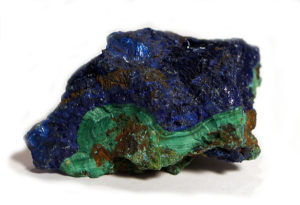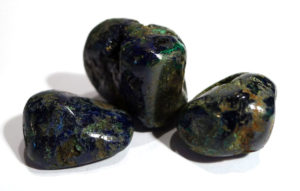Properties:
Azurite is related to malachite, but is distinguished by its colour and lower water content. Azurite can create a strong opening of the Crown and Third Eye Chakras, facilitating and speeding up spiritual and psychic development, as well as opening the Bindu Visarga, aiding attunement and communication with our guides. It is sometimes referred to as the ‘Stone of Heaven’, and promotes awareness and self-knowledge, encouraging a quest towards enlightenment. It can help us to achieve a deep meditative state, and is useful in astral travel. It is most often used in meditation, but can be a useful healing stone, treating liver, kidney and gallbladder problems, and aiding detoxification. It is also useful in stimulating the thyroid, as well as giving insight into the cause of illness. Because of its high copper content, it is sometimes used as a mild pain-reliever.
Malachite is a powerful healer and balancer on every level, and possesses natural bacteriostatic qualities, so can be used to support the immune system and fight infection. Some refer to it as the “midwife stone”, as it is used to ease labour, as well as period pains. With its high copper content, it is believed to draw off heat and inflammation, and so is an effective remedy for relieving osteoarthritis and other inflammatory illnesses or injuries, as well as reducing fever. In combination with carnelian and smoky quartz, it forms a ‘magic triad’ for treatment of lower back pain. Malachite has been used as a protective amulet throughout history, particularly for children. It is often employed to absorb pollution and electromagnetic radiation around computers and other electrical appliances.
Azurite-malachite carries the properties of each of the minerals it contains, In addition, it bestows harmony, particularly in situations of inner conflict, and helps us to find a balance between intellect and emotion.
Attributes:
- Chemical Formula: Cu3(CO3)2(OH)2
- Group: Carbonates
- Crystal System: Monoclinic
- Hardness: 3½ – 4
- Birthstone: Secondary birthstone for Sagittarius and Capricorn
- Chakra: Heart, Upper Heart, Throat, Third Eye and Crown
- Element: Water, Air and Spirit; Wood and Water
Mineralogy:
Azurite forms as a secondary (sedimentary) mineral through the action of carbonated waters on other copper minerals in the oxidised areas of copper deposits. It frequently occurs with malachite. Crystals may be tabular (with crystals often stacked on top of one another), or prismatic (with a wide variety of faces); azurite-malachite also forms stalactitically, botryoidally, and as spherical concretions. Azurite is chemically identical to malachite, but the copper chromophore, Cu2+, occupies different positions in the crystal lattices of the two minerals. As a result, azurite is blue while malachite is green, demonstrating a change in the wavelengths that are absorbed. Much of the polished or tumbled azurite-malachite on the market is actually an amalgam of powder or small pieces of each, held together with resin.
History and Tradition:
Azurite is from the Persian lazhward, meaning “blue” (also the root of ‘lapis lazuli’), in allusion to the colour. Although mined in ancient Egypt and the Sinai, it does not appear to have been used medicinally, but was primarily used as a copper ore and pigment, and possibly a source of blue glaze. Azurite was used for the same purposes in Europe from the 15th to the 17th centuries. There are no healing or talismanic traditions associated with it.
Malachite was named in antiquity after the Greek for mallow, alluding to its resemblance to the green of mallow’s leaves. Malachite is probably one of the most important minerals in human history and culture. There are malachite mines dating back to 4000 BC, most notably in the Sinai. Around this time, it was discovered that heating the mineral in a hot fire would reduce it to copper. This in turn led to experimentation with other minerals, and the development of metallurgy. Malachite can be ground down to produce a rich green pigment, with examples of its use including wall paintings in Ancient Egypt dating from around 3000 BC. The Ancient Egyptians also used the powder as an eye shadow. This would have prevented eye infection (which the Egyptians were prone to), due to its natural bacteriostatic qualities. There are 39 remedies listing the use of malachite in the Ebers Papyrus (an Ancient Egyptian medical treatise dating from around 1500 BC), most of which are treatments for eye problems and infections. Nearer home, malachite was mined for copper in the Great Orme Mine near Llandudno, Wales between 1860 and 600 BC. In Ancient Greece and Rome, malachite was used in protection amulets for children, as mentioned by Pliny the Elder. There are similar references in two 16th century lapidaries(1), recommending it as an amulet for placing in an infant’s cradle, to keep away evil spirits and help the child sleep peacefully. Other European references from the same period recommend it to prevent falls, or bites from venomous creatures, and to protect the wearer from enchantments and evil spirits; it was also purported to break into pieces to warn of danger. In some parts of Italy, as recently as the 19th century, amulets were carved so the layering would resemble an eye to protect the wearer from the spell of the “Evil Eye”. Gienger makes reference to malachite’s connection with goddess worship in many cultures. Gienger’s writing is always well researched, so I have no reason to doubt this assertion, but found no similar references in my own research.


